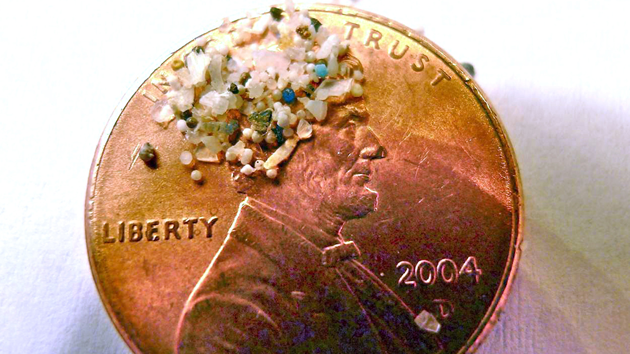
It’s hard to gross out Cindy Zipf. Three decades of cleaning up beaches have inured her to the horrors of, say, a washed-up diaper. But there’s one kind of trash that Zipf, executive director of the New Jersey-based marine protection coalition Clean Ocean Action, really can’t stand: plastic tampon applicators. During a 2014 cleanup of some 70 beaches, Zipf’s team found about 3,000 of them. Plastic applicators are so common, in fact, that kids on the beach often pick them up, thinking they’re toy whistles. “We call them Jersey beach whistles,” says Zipf. “How disgusting is that?”
But applicators are even worse for the ocean once they break down. According to Susan Shaw, the founder and executive director of the Marine and Environmental Research Institute and a leading expert on the plastics in our oceans, sea animals often mistake applicator-sized pieces of plastic for food. When the plastic blocks their digestive tracts, they can starve to death. What’s more, the type of plastic in applicators can break down into tiny pieces easily eaten by shellfish and other small marine creatures. Shaw’s team found an average of 177 pieces of microplastic in each oyster they tested. And that plastic can work its way up the food chain. “That’s pretty scary if you’re a person who’s eating oysters,” says Shaw.
It’s especially scary when you consider that plastic applicators dominate the market. Walk down the feminine-hygiene aisle of any drugstore, and you’ll be hard-pressed to find a tampon with a cardboard applicator or no applicator at all. According to research provided by manufacturer Kotex, sales of cardboard applicator tampons have declined nearly 40 percent since 2013. More than 88 percent of the estimated $1.1 billion worth of tampons sold in 2015 had plastic applicators.
So why are tampon companies hell-bent on making applicators out of ocean-polluting plastic? “Our research has indicated that consumers find these types of tampon applicators to be preferred versus cardboard applicator tampons, especially in the areas of ease of use and comfort to insert,” a Kotex spokesman wrote to me in an email. Other manufacturers’ packaging hits some of the same notes. Tampax, for example, promises that the plastic applicator on its Pearl model “is smooth and rounded, making it super easy to insert.” What’s more, it adds, “contoured Anti-Slip Grip™ makes the applicator easier to hold and position, which is great for girls just learning how to insert a tampon.”
Kate Connors, a spokeswoman for the American College of Obstetricians and Gynecologists, is not aware of any medical data or scientific evidence suggesting that plastic applicators are better for women’s bodies than cardboard applicators or applicator-free tampons. (For that matter, there’s never been an independent study on whether plastic applicators contain hormone-disrupting substances like BPA and phthalates. Kotex and Tampax both assured me that their applicators don’t contain any hormone disruptors. A Kotex spokesman said the company “does not disclose composition due to vendor confidentiality agreements.”)
Susie Hewson, a veteran of the feminine-hygiene industry and founder of the plastic-applicator-free tampon manufacturer Natracare, believes the switch from cardboard to plastic had more to do with marketing than comfort. Playtex introduced the plastic applicator in the mid-’70s, but it wasn’t until decades later that the product took off—largely due to a campaign by Procter & Gamble, which acquired market leader Tampax in 1997. Procter & Gamble “wanted to move away from the ‘tampon my mother uses’ reputation it felt its cardboard applicator communicated,” recalls Hewson. Not wanting to be perceived as old-fashioned, other manufacturers quickly followed suit, she says.
Back when plastic applicators were first becoming popular, Zipf and her team worked with state legislators to introduce bills to ban their sale. Tampon manufacturers fought this aggressively: “They went to colleges and bused in women to say that they should be able to choose the tampon applicator of their choice, that it was a women’s rights issue,” Zipf remembers. The bills failed, and today, she says, her cleanup crews see more plastic applicators than ever before.
Of course, plastic applicators shouldn’t end up in the ocean in the first place, since you’re not supposed to flush them. But lots of people do—and that’s terrible news for sewage treatment facilities, where they can gum up the works. Jennifer Cabral, a spokeswoman for the Orange County Sanitation District, says her team regularly encounters plastic applicators, which contribute to the clogging incidents that cost her agency about $300,000 in 2014. When aging sewage systems become overwhelmed, applicators can flow with storm surges directly into waterways—one of the most common pathways by which they get into the ocean.
Meanwhile, when I asked major tampon manufacturers whether they were concerned about plastic applicators littering the seas, not a single one had a concrete answer. Kotex “continues to look for new product opportunities to support both consumer needs and sustainability goals,” a company spokesman vaguely wrote to me. Advocates like Zipf hope he’s serious. “These people spend millions of dollars on product design,” she says. “How hard would it be to make something that isn’t going to end up in an albatross chick’s stomach?”













